This was published 3 years ago
River managers fight to save Menindee Lakes from flood of deadly blackwater
By Mike Foley
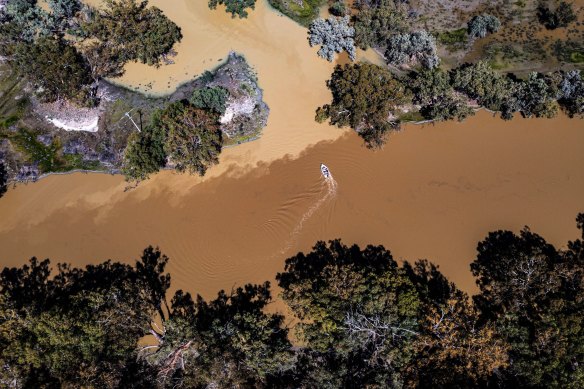
Water from Emu Lake mixes with the darker deoxygenated water in the Darling River.Credit: Nick Moir
Deadly blackwater is crawling slowly across the plains of Far West NSW, heading south down the Darling Baaka River towards Menindee Lakes and the site of the catastrophic 2019 fish kills that wiped out a million native cod, yellowbelly and bony herring.
But river managers are mounting a rescue effort to minimise the damage.
The deoxygenated blackwater is slowly snaking its way south along the vast northern Murray Darling Basin, swelling as it picks up blackwater inflows from previously dry floodplains around Walgett, Brewarrina, Bourke, Louth, Tilpa, Wilcannia and now Menindee.
It’s a natural phenomenon spurred by post-drought rains that soaked the once parched plains across the Barwon-Darling catchment. It began in the north on the border between Queensland and NSW, around Mungindi, and the flood is bulging down the river, carrying away a decade’s worth of leaf litter and paddock stubble with it.
Water moves slowly here so fish will have days dealing with the blackwater, even if they try to swim through it.
Iain Ellis
Bacteria breaks down this organic matter and releases significant amounts of dissolved carbon into the water. The carbon removes dissolved oxygen in the water, making it hard for aquatic creatures to breathe.
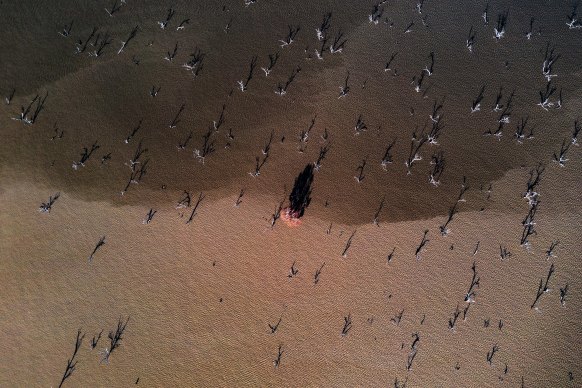
Darker deoxygenated water in Lake Pamamaroo.Credit: Nick Moir
NSW Fisheries aquatic habitat rehabilitation manager Iain Ellis is working with other water managers to try and minimise losses when the blackwater hits the Menindee Lakes system, 200 kilometres upstream from Wentworth and junction of the Darling Baaka and the Murray rivers.
This blackwater event doesn’t only threaten fish in Menindee Lakes. Those living in the river upstream need somewhere to swim out of the way as the wall of deoxygenated water rolls slowly by. But there’s not many options for fish to take evasive action on the Darling Baaka.
“When they smell the rubbish water coming, fish will shift into a big lake if it’s available, or head up a tributary that might have better water quality,” Mr Ellis said. “The thing concerning me is once you get past about Bourke you don’t have tributaries contributing to the Darling.
“Water moves slowly here, so fish will have days dealing with the blackwater, even if they try to swim through it.”
There have been relatively small fish kills in the river already, with fish dying in their hundreds. But the Menindee Lakes, a natural ephemeral lake system that was engineered with weirs into water storages in the 1940s, is full of breeding fish. Concerns are running high for the Darling Baaka River ecosystem following the catastrophe of 2019.
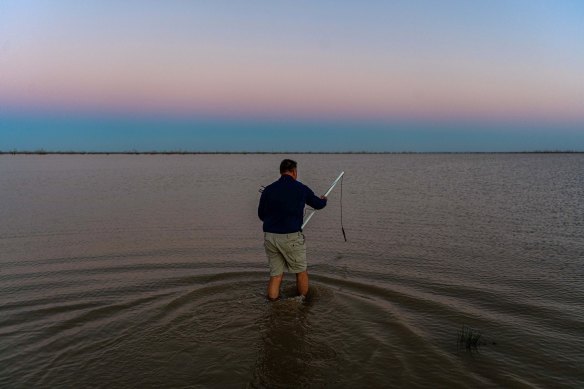
Graeme McCrabb takes oxygen and temperature readings from the Menindee Lakes. Credit: Nick Moir
Australia’s inland waterways are shaped by a cycle of droughts and floods. Native fish evolved for this boom-bust existence and are bouncing back from the latest disaster three years ago.
Many locals blame the state and Commonwealth river managers for the 2019 fish kills, when a million native fish perished with shocking footage capturing international headlines.
The lakes were full after an unusual winter rain event in 2016, but in the following years they were drained to water downstream reaches of the Murray Darling system, and to avoid losses to evaporation.
By the end of 2018, the river below Menindee Lakes had dried into a series of disconnected pools. A run of scorching days baked the pools and algae proliferated, leading to a lower layer of deoxygenated water in the pools.
At that stage, the surface layer retained enough oxygen for the fish to breathe and they congregated there. But in early 2019 a cold snap bearing rain came through and mixed the deoxygenated lower layers with the surface water, effectively deoxygenating the whole pool and fish died in droves.
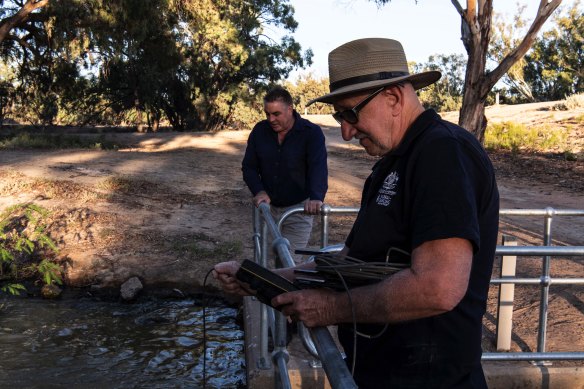
Graeme McCrabb and Richard Unsworth monitoring oxygen and temperature levels in the Menindee Lakes.Credit: Nick Moir
The past two years have been wetter than average, driven by a La Nina weather system. Mr Ellis said the fish in Menindee Lakes, which is a key nursery dispersing fish throughout the Murray Darling Basin, are in the early stages of a promising recovery.
“Another three or four of good years and we’re well on the way to recovery for Murray cod, as nasty as it was. And those fish can help reseed the Murray River downstream. There’s massive amounts of juveniles in the lakes and the Lower Darling and the anabranch, and they’ve been moving back upstream in the past 12 months.”
Water agencies will lend a helping hand by herding the black tide through the man-made lake system to “shandy up” the rubbish water with the sweetwater that’s sitting in the lakes.
WaterNSW systems operations manager Adrian Langdon said blackwater had already started to pool in Lake Wetherell, the body of water that backs up behind the gated entry to the Menindee Lakes proper, comprised of Pamamaroo, Menindee, and Cawndilla lakes.
To protect the fish in Wetherell from blanket blackwater coverage, river operators will strategically open that gate and direct water around the other lakes in separate bursts by opening in turn the gates to Menindee, Pamamaroo and Cawndilla lakes.
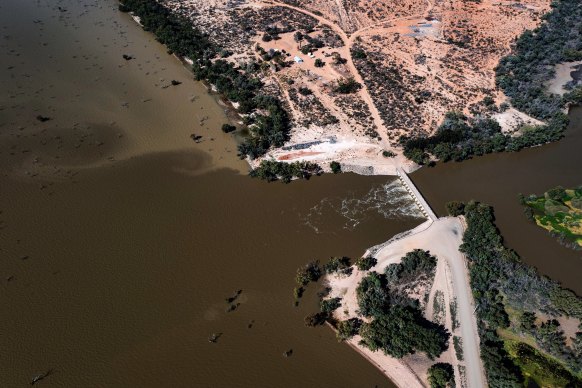
Darker deoxygenated water entering Pamamaroo. Credit: Nick Moir
Mr Langdon said river operators “don’t have massive control” over the situation, but hopefully they can create “enough refuges for the fish to survive”.
“While there will be patches of blackwater, there’s a lot of good quality water too, and generally the fish, especially the babies, move right away from the hypoxic water,” he said.
“It can take up to 30 days for this carbon to break down and before we start to see oxygen levels rise.”
The weather is a wildcard for the lakes, with temperatures forecast to hit 38 degrees by Tuesday.
“If you put a tea bag in a pot of cold water you’ll only get a little bit of colour come out. If you put it in hot water, you’ll get a proper cup of tea, and that’s what we’re facing now,” Mr Ellis said.
Murray Darling Basin Authority community engagement officer Richard Unsworth said community wellbeing in Menindee had risen with the return of good river flows and a healthier lake system, with locals taking an active role in environmental management.
“We’ve got landholders, businesses and Barkindji rangers working with government agencies to check oxygen levels in their part of the lake system, and that information is feeding directly into decision-making by the various water and environmental agencies,” Mr Unsworth said.
Menindee resident Graeme McCrabb says some in the district are frustrated that WaterNSW has not released enough water from the brimming lakes for the flow down the Lower Darling Baaka to top the banks and inundate the floodplain.
River managers say they have been warned that doing so is an unacceptable flood risk to some properties along the river.
“The floodplain is just such an integral part of a river system and it gets so forgotten all the time. It’s been 10 years since we’ve got water on it now,” Mr McCrabb said. “We’ve just missed a once-in-a-decade opportunity to do it. Hopefully we get another chance in the coming years.”
A guide to the environment, what’s happening to it, what’s being done about it and what it means for the future. Sign up to our fortnightly Clear Air newsletter here.